I despise unsanitary kitty litter, and with Bengals being so intelligent this training was a must for our girls. Unfortunately the process has not been as easy as I had hoped, but we are persisting.
The three training discs (red, green and amber) fit inside a white universal base plate that looks like a toilet seat and fits most standard toilets. You just raise the existing seat & sit the Litter Kwitter onto the porcelain rim of the toilet bowl. But before you do that, there are some things you need to do first.
Steps to toilet training:
1) Familiarize your cat with the Litter Kwitter.
We bought Azaria and Kahlia as 12 week-old kittens, so we started using the Litter Kwitter in the bathroom as soon as they came to our home. But if your cat is using an existing litter tray elsewhere, you need to gradually move it to the vicinity of the toilet over a period of days.
Once you have transitioned kitty’s existing litter tray next to the toilet, it’s time to replace tray with the Litter Kwitter. All other litter trays need to be removed completely, making the Litter Kwitter the only option. (Note: if you have an outdoor/indoor cat then toilet training may not be for you; during the training your cat may opt to just ‘hold on’ until it gets let outside, which can increase the likelihood of urinary health problems).
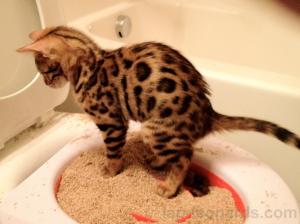
2) Bottom up!
You begin with the Litter Kwitter on the floor, until your cat becomes accustomed to their new tray. This is part of the ‘red stage’; the white base-plate with the red tray inside. Because Azaria and Kahlia were kittens we stayed at this stage for about 3 weeks, until we were comfortable that they were old enough not to fall in the toilet and drown.
Both of our girls had an accident each during this time; Azaria was ill and diarrhea got the better of her – and our bedspread! Not long after Kahlia also thought our bed would make a nice place to potty and peed right in the middle of it. *sigh*
On this note it’s important to mention that if your cat has a misfortune such as this, don’t punish them. Cats are not dogs and they don’t learn this way. Yelling, spanking or rubbing their nose in it will only make them fearful of you, and the stress is likely to make the behavior worse. Keep a close eye on them, and if you catch them scratching like they are about to go, pick them up and place them in the litter tray. Then reward the correct behavior with treats and/or lots of praise. Cats will respond much better to positive reinforcement than punishment.
It’s also important to clean the soiled area well, as traces of the urine smell will only entice your cat back to the same spot. Normal detergent-based cleaners will not work; while the smell may appear to be gone, a cat’s sense of smell is about 10 times stronger than ours and chances are they will still detect it. Not only that, cat’s urine forms crystals upon drying which reactivate their odor in heat or moisture, which is why pungent cat urine is so persistant. Enzyme-based cleaners are the best as they actually break-down these urine crystals and neutralize the smell. I started with a product called ‘Urin-Off‘, however do not like the smell so I switched to Bissell’s ‘Ewww‘. My vet also recommended ‘Anti-Icky-poo‘ as a very effective product.
3) Go at your cat’s pace. 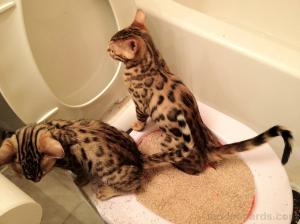
It’s important not to rush your cat through the training, rather go at a pace they are comfortable. Once we felt they were ready, we transitioned the Litter Kwitter onto the toilet and provided a small step to make it easily accessible for the girls. This part was easy; they made this transition really well. We still needed to keep a close eye on Kahlia who would scratch in inappropriate places both before and after the transition, but generally they were doing great… that was of course until 2 weeks later when we tried to move on to the ‘amber stage’.
Both girls were somewhat fascinated with the hole that now appeared in the amber tray of their litter box, and with scooping litter into the said hole. But peeing in it was a completely different story; they were not impressed and would cry when they needed to go. So we switched back to the red tray and all was good with the world again.
 Not long after the girls were spayed and had to endure the next 2 weeks with cones on their heads. So we regressed even further; back to the litter on the floor out of fear they would lose balance on the toilet and injure themselves. Back to square one.
Not long after the girls were spayed and had to endure the next 2 weeks with cones on their heads. So we regressed even further; back to the litter on the floor out of fear they would lose balance on the toilet and injure themselves. Back to square one.
Kahlia was still a problem too; despite our efforts she returned to pee on our bed… and our couch…and our office, and in the bathtub. *sigh* So today it was back to the vet to ensure there is nothing medically wrong. Urinary tract infections can be painful, and cats can associate the pain with their litter tray and therefore try to avoid it. We will have the results back in a few days.
If the issue is not medical, then there are some other reasons she may have an aversion to the litter box:
1) Cleanliness – Cats like clean litter, so I change the litter and wash the Litter Kwitter every day. I don’t use harsh chemicals which can be offensive to cats (I rinse it with hot water). And Kahlia has urinated inappropriately even after the litter was freshly changed, so I don’t think this is the reason. But she is sharing the litter with Azaria, which leads me to the next possible cause…
2) Sharing the litter box – Some cats just don’t like to share! Kahlia and Azaria are best buddies do everything together, often even using the toilet at the same time. But this may in fact be the very issue. I have already purchased another Litter Kwitter from Amazon and am waiting for it’s delivery.
3) The type of litter – Maybe Kahlia just doesn’t like the type of litter we buy. We have been using Swheet Scoop; a non-scented, flushable litter. But if all else fails it’s time to do a litter test; try one type of litter in the first Litter Kwitter and another type in the alternate Litter Kwitter and see which one is preferable.
At any rate I’m going to be patient and keep persisting. It’s worth the investment to be done without smelly, unhygienic kitty litter forever! Stay tuned to part 2 to see how it all turns out!
If you have any other suggestions or tips I welcome your comments 🙂
Continue to Bengal Toilet Training, Part 2.
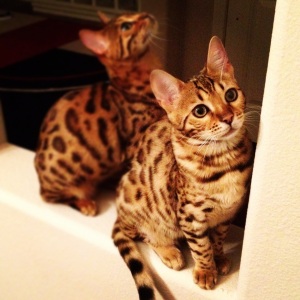 It has been 4 months since I posted Part 1 of our Bengal toilet training endeavors, and unfortunately we are still in training.
It has been 4 months since I posted Part 1 of our Bengal toilet training endeavors, and unfortunately we are still in training.
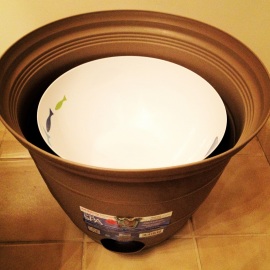
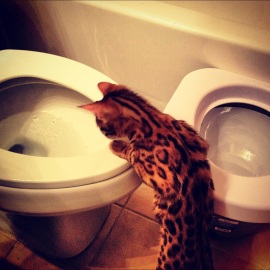


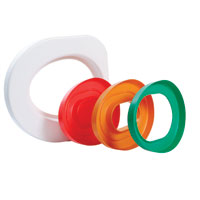


 Not long after the girls were spayed and had to endure the next 2 weeks with cones on their heads. So we regressed even further; back to the litter on the floor out of fear they would lose balance on the toilet and injure themselves. Back to square one.
Not long after the girls were spayed and had to endure the next 2 weeks with cones on their heads. So we regressed even further; back to the litter on the floor out of fear they would lose balance on the toilet and injure themselves. Back to square one.